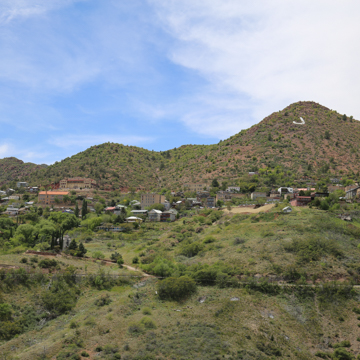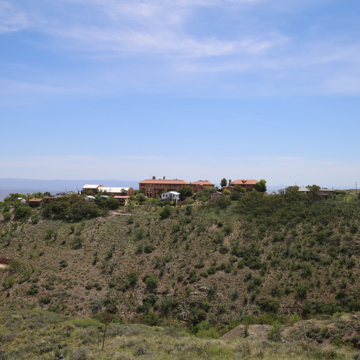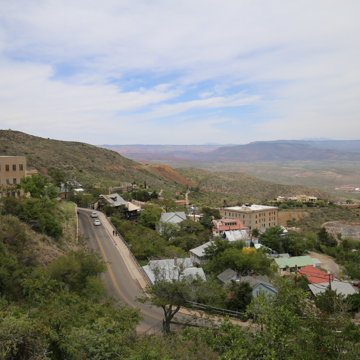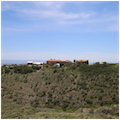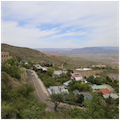Nestled in central Arizona’s Black Hills, Jerome, like Bisbee to the south, was an important copper mining center during the late nineteenth and early twentieth centuries, and its output contributed to Arizona’s position as the nation’s leading copper-producing state in 1907. Although the town is associated with the United Verde Copper Company (UVCC), Jerome was not a true company town in the sense that it was owned and developed by a single corporation, although its existence was in fact entirely dependent on the local mining industry. Once the fourth largest city in the Arizona Territory, Jerome’s most significant period of development, from about 1890 through 1930, attests to the town’s prosperity. Like most American mining towns, however, as the industry tapered in the mid-twentieth century, so did Jerome’s good fortunes and vitality.
The remote, rugged area’s mining history extends from the prehistoric era, when Native Americans likely mined the exposed surfaces of the ore veins for malachite and azurite to use as pigments. Following European contact, a Spanish expedition led by Antonio de Espejo noted silver ore in 1583, and Captain Marcos Farfán de los Godos returned in 1598 to stake mining claims. Jerome’s townsite was marked in 1876 with Morris A. Ruffner and August McKinnon’s discovery of high-quality copper ore on cone-shaped Cleopatra Hill, but a significant mining enterprise was not truly developed for another six years, when the arrival of the Atlantic and Pacific Railroad in Ash Fork (60 miles to the northwest) made the transportation of ore from this remote location profitable. The existing tent settlement was named for Eugene Jerome, the American grandfather of Winston Churchill and a New York financier who, with other investors, formed UVCC in 1882. The following year, UVCC built a small smelting works and forged wagon roads south to Prescott to transport the ore retrieved from their United Verde mine.
In 1888, following a drop in copper prices and a brief period of inactivity, the UVCC holdings were sold to William Andrews Clark, a Montana mining magnate and future U.S. Senator (1901–1907). Clark laid a narrow-gauge rail line in 1893 from the mining town west to Jerome Junction, to connect outgoing ore with the standard-gauge Santa Fe, Prescott and Phoenix Railway, which, in turn, connected north to Ash Fork. Clark’s enterprise improved Jerome from a wild, lawless mining camp into a mining, smelter, and railroad complex that out-produced Bisbee’s famous Copper Queen mine by 1900. In that same period, Jerome’s population expanded tenfold, from 250 persons in 1890 to more than 2,500 in 1900, and peaking at 15,000 by 1929. Cosmopolitan in its ethnic composition, Jerome attracted Anglo-American, Mexican, Irish, Italian, Croatian, and Chinese laborers and miners. As the populace was still predominantly male (78 per cent in 1900), Jerome’s “Cribs District” was marked with some 86 saloons, gambling establishments, and brothels on a back alley known as “Prostitution Row,” leading a New York Sun writer to call it the “wickedest town in the West” in 1903.
Perched on the side of Cleopatra Hill (5,200 foot elevation), high above the Verde River Valley, Jerome’s form follows the slope’s natural and unforgiving topography while its built fabric is due, in large part, to the individual settlers (for the most part, in the early years, UVCC took a laissez-faire, if not neglectful, attitude to the workers’ living conditions). Early frame dwellings, shakily resting upon stilts to better negotiate the sheer mountain slope, were haphazardly placed vis-à-vis the narrow, steep, switchback streets, filling all available, stabilized plots in a limited area. Like Bisbee, steps and stairs characterize the hill town. About 1882, a downtown area was created atop a short grid pattern nestled between the ridge roads of Main and Clark streets. By 1890, Jerome’s downtown had a post office (1883), a schoolhouse (1884), a public library (1889), and the Hotel Connor (1890), among others. However, four major conflagrations between 1894 and 1899 destroyed much of the original, wooden (and canvas) built material in the business district as well as surrounding residences. In 1899, Jerome was incorporated as a town, which gave the municipality the right to collect taxes (some of which went to form a firefighting brigade) and establish building codes that promoted masonry construction. Thus, the majority of buildings in downtown Jerome date after 1899. By 1900, the bustling town boasted telephone service and electric lights and contained churches, banks, four hospitals, two opera houses, fraternal-order halls, hotels, and shops.
Between the forces of gravity upon Cleopatra Hill’s 30-degree slope and the unstable scree further destabilized by the warren of subterranean tunnels and shafts, Jerome’s buildings literally started to slide downhill, resulting in the witticism that Jerome was “a town on the move.” In addition, the mountainside could not bear further growth; Jerome’s urban fabric had become so dense that critics decried it as overcrowded and unsanitary. So, in 1910, Clark purchased several ranches in the Verde Valley, six miles northeast of Jerome, mostly on Verde River valley plains, and founded the smelter town of Clarkdale. A UVCC engineer laid out the new town, and this planned community—a true company town—boasted water, electric lights and power, sanitation, and even police protection, while new and improved housing was designed by a Los Angeles-based architect. This attention to workers’ living conditions was meant to attract and retain steady employees with families, thereby combatting the lawlessness and vice that plagued Jerome’s predominantly male population.
As UVCC’s attention shifted to Clarkdale, however, another mining company began to influence Jerome’s built environment. In 1912, James Stuart Douglas Jr. invested in the Little Daisy Mine with mineral surveyor J.J. Fischer, and created the United Verde Extension (UVX) company. Douglas first brought in Phoenix-based architects Lescher and Kibbey to design his adobe mansion in 1916 and the Little Daisy Hotel, a dormitory for UVX miners, in 1918. The architectural firm returned to build the first United Verde Hospital (1920) and Jerome High School (1923), while the successor firm, Lescher and Mahoney, is credited with the second United Verde Hospital (1927) for Clark’s UVCC. The Douglas Mansion is now the centerpiece of the Jerome State Historic Park, established in 1962.
The town’s early-twentieth-century history, as well as its built material, reflects larger patterns in American labor relations: in 1917, some of Jerome’s miners invited the Industrial Workers of the World (IWW) to establish a chapter there, which outraged Clark as well as a local competitor union. This tension instigated a 1,500-person walkout on July 5; the strike was broken within five days, when 250 armed vigilantes marshaled 67 unionists and deported them (via a railroad cattle car) first to Needles, California, and then back to Kingman, Arizona. This was the last unionization attempt in Jerome; thenceforth, wages and working conditions stagnated. However, UVCC, in an attempt to quell future agitation and unrest, duly responded by giving its employees disability and life insurance benefits while providing built amenities, such as improved workers’ housing west of central Jerome and in Clarkdale, and a baseball field, tennis courts, swimming pools, and a public park in Jerome. In addition, UVCC donated money for the upkeep of the Jerome public library and financed civic projects such as improvements for churches, schools, and hospitals.
Under the banner of UVCC, by 1923 Clark had produced more than one billion pounds of copper, more than 500,000 ounces of gold, and 18.5 million ounces of silver from the Jerome works (while augmenting his multimillionaire status in the process). After his death, his heirs assumed the mining works, which were hampered with the onset of the Great Depression and a commensurate drop in precious metal prices, and they stopped all production at the United Verde mine in 1931. Meanwhile, ongoing subsidence wrought by the purported 88 miles of shafts and tunnels damaged at least ten buildings in downtown Jerome in 1928, and more in the 1930s, when dozens of buildings, including the old post office, were lost in sinkholes while the concrete jail slid dozens of feet down Cleopatra Hill. In 1935, the Phelps Dodge Corporation (PD) acquired the UVCC property including the town of Clarkdale, which became a presence in, but not the owner of, the independent municipality of Jerome. Although the demand for copper rose again during World War II, it declined permanently in the postwar era, and over-mining had already depleted the area’s ore deposits. PD ceased all large-scale mining at the UVCC mine in 1953, and immediately, Jerome was reduced to a ghost town with only a few hundred people. The enormous Clarkdale smelter was dissembled and shipped to PD operations elsewhere. The remaining residents formed the Jerome Historical Society in 1953 and opened a museum to attract tourism. In 1967, the town and most of the Jerome UVCC mine and housing properties were designated a National Historic Landmark. Today, Jerome is a tourist attraction and artists’ community with a population of 450 people. The town’s historic downtown buildings cater to tourists as retail or restaurants, while a number of the larger buildings have been converted to hotels.
References
Crawford, Margaret. Building the Working Man’s Paradise: The Design of American Company Towns. Verso, 1995.
Schwantes, Carlos A. Vision and Enterprise: Exploring the History of Phelps Dodge Corporation. Tucson: University of Arizona Press, 2000.
Snell, Charles W., “Jerome (United Verde Mine),” Yavapai County, Arizona. National Survey of Historic Sites and Buildings Form, 1966. National Park Service, U.S. Department of the Interior, Washington, D.C.
Steuber, Midge. Jerome. Mount Pleasant, S.C.: Arcadia Publishing, 2008.
Town of Jerome. “Jerome, Arizona.” Accessed April 21, 2016. http://www.azjerome.com/.
Trimble, Marshall. Roadside History of Arizona. Missoula, MT: Mountain Press Publishing Company, 1986.














